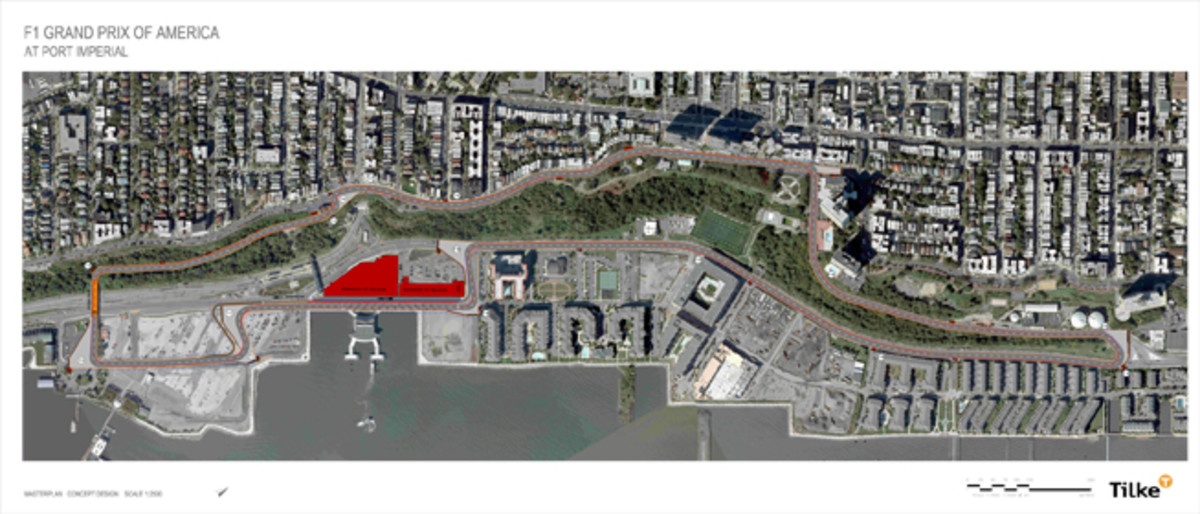What you need to know about Formula 1 coming to New York
WEEHAWKEN, N.J. -- New Jersey may sound like an unlikely tour stop on a Formula 1 circuit that includes such exotic locales as Monte Carlo, Abu Dhabi, Shanghai, Sao Paolo and Kuala Lumpur. But that's exactly where the world's richest and most-watched motor sport is coming in June 2013, when the Grand Prix of America begins running along the banks of the Hudson River in West New York and Weehawken. Here are five things you need to know from Tuesday's announcement:
New Jersey will provide the stage, but New York will provide the scenery. The 3.2-mile course will run on existing public streets from the start/finish line at Port Imperial (the ferry terminal where Tuesday's press conference was held), rising some 150 feet along the precipitous New Jersey Palisades before looping back down along the Hudson waterfront. It's very much a New Jersey event -- Gov. Chris Christie said the race will generate approximately $100 million annually in economic activity for the state -- but the deal-maker was the proximity of the course to New York City, where F1 boss Bernie Ecclestone has long fancied holding a Grand Prix. "Formula 1 is very much a TV sport and it looks for tremendous backdrops," Steve Matchett, a Formula 1 commentator for Speed Channel, told the assembly of local and international press. "As we look behind us here at the cityscape of Manhattan, it's going to be something the whole world will recognize instantly."
• Click here to see a high-res PDF of the race course (Warning: large file)
No taxpayer dollars will be spent. New York media magnate Leo Hindery, who founded the Yes Network in 2001, is the lead organizer for the race and appears to be embracing his role as a promoter. Rather than depending on a state-funded subsidy to cover the hefty annual sanctioning fee -- a figure that remained undisclosed Tuesday but is thought to be in the neighborhood of $30 million -- Hindery and his group of investors will foot the bill throughout the life of the 10-year agreement. That means no government subsidies or compensation of any sort. "Every expense, whether it's public safety, whether it's cleanup, will be covered by the promoters," Hendery said, a guarantee he made Christie when they first met. That was good news for Mayors Richard Turner of Weehawken and Dr. Felix Roque of West New York, whose cities will receive some renumeration for the courtesy of hosting the race. Hendery also noted the cost-saving measure of hosting the race on existing roads rather than a special purpose-built facility. "There's not a yard of dirt or a foot of asphalt that goes in," he said. The only projected infrastructre costs are the grandstands (which will seat 75,000), repaving of the roads, concrete barriers and the garage -- which was already under construction Tuesday behind the press conference.
They will not be racing in your backyard. New Jersey won't be the first urban residential setting to host the Formula 1 traveling circus, where most of the events incorporate local streets. Throughout a two-year planning process, Hindery looked to other "models of success" in Valencia, Shanghai and Singapore, whose breathtaking photogenic nightscapes are among the sport's most glamorous advertisements. Despite the heavy volume of residential housing within spitting distance of the course, there is not a single residence within the circumference of the track. Hindery said access to "a half-dozen houses" along the Palisades on the course's upper portion could be affected, but measures will be taken to ensure easy access. "There won't be one individual who won't be able to get to his or her house on the three race days," he said. Myriad public-transit options made the site a no-brainer, with the ferry terminal, light rail system and the PATH making it what Hindery called "the only truly green race in all of Formula 1."
The course itself is promising. The German engineering firm Tilke GmbH, whose previous racetrack projects include the Bahrain International Circuit, Turkey's Istanbul Park and the Korea International Circuit, was responsible for the course design. Matchett likened the elevation change and waterfront locale to the prestigious Monte Carlo Grand Prix -- Formula 1's signature event -- and praised the demanding blend of fast straights and slow chicanes. "I have no doubt this will be one of the great marquee racing events in history," said Humpy Wheeler, a legend in race promotion and a consultant to Hindery's investment group. "I couldn't have conceived a better course than this one here."
It may fall on deaf ears in a crowded sports market, but this is a big deal. This isn't the first time the famed open-wheel circuit has tried to gain a stateside foothold. The United States Grand Prix was held in Watkins Glen, N.Y., from 1961 until 1980, with subsequent events in Long Beach, Calif., Las Vegas, Detroit, Dallas and Phoenix. (Lewis Hamilton won the last USGP at Indianapolis in 2007.) But Formula 1, which claims more than a billion fans, is the No. 1 sport worldwide in revenue produced per event, a fact not lost on Christie and the many local officials at Tuesday's announcement. Media coverage was intense: Twenty-one news cameras and dozens of international media were on hand, with many headed directly to the airport afterward to catch up with the F1 circuit in Greater Noida, India. The three-day event is expected to attract 100,000 people, with the average price of a three-day ticket around $360. Whether it can capture the imagination of American sports fans remains to be seen, but there's little doubt the world will be watching.






